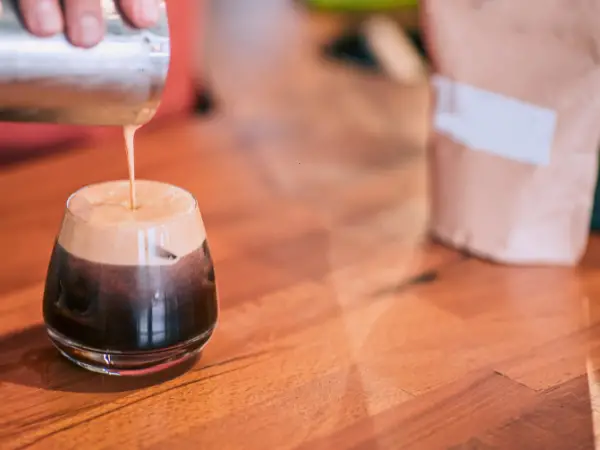Many coffee lovers wonder what sets third-wave coffee apart from other types. Unlike the first and second waves, which prioritized convenience and mass production, the third wave emphasizes quality, sustainability, and flavor.
Coffee is treated like fine wine, with attention to origin and preparation. This guide will explore the key elements that define third-wave coffee.
What Is Third-wave Coffee?
Exploring Third-Wave Coffee reveals a fascinating journey in the world of coffee. This movement emphasizes high-quality coffee and a deep appreciation for its origins.
The Evolution Of Coffee Waves: First, Second, And Third
The coffee industry has evolved through three distinct waves. Each wave represents a different approach to coffee production and consumption. Understanding these waves helps clarify what makes third-wave coffee unique.
- First Wave: Focused on convenience.
- Second Wave: Introduced specialty coffee shops.
- Third Wave: Celebrates coffee as an artisanal product.
| Wave | Characteristics | Examples |
|---|---|---|
| First Wave | Mass production and instant coffee. | Folgers, Maxwell House |
| Second Wave | Espresso drinks and coffee culture. | Starbucks, Peet’s Coffee |
| Third Wave | Artisanal practices and single-origin beans. | Blue Bottle, Stumptown |
First-wave coffee made it easy to drink coffee anywhere. Brands focused on getting coffee to the masses. Second-wave coffee introduced cafés where people could enjoy espresso drinks. Starbucks and Peet’s Coffee popularized this wave.
Defining The Third Wave: A Focus On Quality And Artisanal Practices
Third-wave coffee brings a fresh perspective to coffee drinking. It treats coffee as an artisanal product. This wave emphasizes several key principles:
- Quality: Sourcing high-grade beans.
- Transparency: Knowing the origin of each bean.
- Craftsmanship: Using careful brewing methods.
Third-wave coffee shops often serve single-origin coffee. This means each cup comes from a specific region. Drinkers can taste the unique flavors based on where the beans grow. Baristas are trained to highlight these flavors through different brewing techniques.
Customers engage in the process, learning about their coffee. Many shops offer tasting flights, allowing people to compare different beans. This interaction deepens appreciation for the craft.
Key Features Of Third-wave Coffee
The key features of third-wave coffee focus on crafting exceptional coffee experiences. Understanding these features helps you appreciate the depth of flavor in each cup.
Single-origin Beans And Their Importance
Single-origin beans are a cornerstone of third-wave coffee. These beans come from one location, such as a specific farm or region. This focus allows for unique flavor profiles that reflect the land where they are grown. Here are some reasons why single-origin beans matter:
- Flavor Diversity: Each region produces beans with distinct flavors. For example, Ethiopian beans often have fruity notes.
- Quality Control: Farmers control the quality of their beans. This leads to better tasting coffee.
- Connection to Place: Single-origin coffee tells a story about its origin. Drinkers can appreciate the journey from farm to cup.
Consider the following table that highlights some popular single-origin regions and their flavor notes:
| Region | Flavor Notes |
|---|---|
| Ethiopia | Floral, fruity, bright acidity |
| Colombia | Nutty, caramel, medium body |
| Guatemala | Chocolate, spice, full body |
Single-origin beans provide a rich coffee experience. They connect drinkers to the land and people behind each cup.

Emphasis On Brewing Methods And Techniques
Brewing methods in third-wave coffee focus on precision and technique. Each method brings out different flavors in the coffee. Popular brewing techniques include:
- Pour Over: This method allows for careful control over water flow and temperature.
- French Press: Coarse grounds steep for a full-bodied coffee experience.
- Aeropress: A versatile tool that brews coffee quickly with pressure.
Each technique enhances specific flavors. For instance, pour over methods highlight acidity and brightness. On the other hand, French press offers a richer body.
Equipment quality matters too. Using fresh, clean tools helps maintain the coffee’s integrity. A well-maintained grinder produces uniform grounds. This ensures even extraction during brewing.
Transparency In Sourcing And Ethical Practices
Transparency is vital in third-wave coffee. Consumers want to know where their coffee comes from and how it is made. This movement emphasizes ethical practices in sourcing:
- Direct Trade: Many roasters buy directly from farmers. This builds relationships and ensures fair prices.
- Sustainability: Farmers are encouraged to use sustainable practices. This protects the environment and supports local communities.
- Certifications: Look for certifications like Fair Trade or Rainforest Alliance. They indicate ethical sourcing practices.
Transparency builds trust. Knowing the origin of your coffee enhances the enjoyment of each cup. Many brands share their sourcing stories through websites and labels. This connection makes coffee drinking more meaningful.
Third-wave Coffee Vs. Traditional Coffee
Third-wave coffee emphasizes quality, sustainability, and unique flavors. Traditional coffee focuses more on convenience and mass production.
Differences In Taste And Flavor Profiles
Third-wave coffee offers a diverse range of taste and flavor profiles. It celebrates the unique characteristics of each coffee bean. Here are some key points:
- Flavor Complexity: Third-wave coffee showcases bright acidity and fruit notes.
- Origin Characteristics: Each coffee reflects its growing region’s soil and climate.
- Brewing Techniques: Methods like pour-over or siphon enhance flavors.
In contrast, traditional coffee often has a more uniform taste. Many traditional brews tend to be bitter and heavy. The focus is mainly on strong caffeine content rather than flavor.
Here’s a simple table highlighting the differences:
| Aspect | Third-Wave Coffee | Traditional Coffee |
|---|---|---|
| Taste | Complex, varied, and bright | Uniform and strong |
| Focus | Flavor and origin | Caffeine content |
| Brewing Methods | Artisanal techniques | Automated brewers |
The Role Of Specialty Roasting In The Third Wave
Specialty roasting plays a crucial role in third-wave coffee. It focuses on the bean’s unique qualities. Roasters pay close attention to the following:
- Bean Selection: Only high-quality beans are chosen.
- Roasting Profiles: Roasters customize profiles to enhance flavors.
- Freshness: Coffee is often roasted in small batches for peak freshness.
This careful approach contrasts with traditional roasting. Traditional methods often use dark roasting, leading to burnt flavors. The goal is to create a consistent product, not to highlight the bean’s characteristics.
How Third-wave Cafes Redefine The Coffee Experience
Third-wave cafes offer a unique coffee experience. They focus on education and community. Here’s how they stand out:
- Barista Training: Baristas are trained to understand coffee deeply.
- Customer Engagement: Cafes encourage customers to learn about their coffee.
- Atmosphere: The ambiance is often cozy and inviting.
Cafes also prioritize quality over speed. Customers can expect a slower, more thoughtful process. This allows for better appreciation of the coffee.
The Role Of Technology And Innovation
The role of technology and innovation is crucial in this journey. It helps coffee enthusiasts create the perfect cup. From advanced brewing tools to the use of data, technology shapes the future of coffee.
Advanced Brewing Equipment In Third-wave Coffee
Advanced brewing equipment sets third-wave coffee apart. Traditional methods focus on basic brewing. Third-wave coffee embraces new technology. This includes precise temperature control and innovative brewing techniques.
Popular advanced brewing methods include:
- Pour-over
- Aeropress
- Siphon brewing
- Cold brew
Each method highlights unique flavors and aromas. For example, pour-over allows for careful water flow. This enhances the coffee’s taste.
| Brewing Method | Features | Flavor Profile |
|---|---|---|
| Pour-over | Manual, controlled flow | Crisp, clean |
| Aeropress | Pressure brewing | Rich, bold |
| Siphon | Vacuum brewing | Complex, layered |
| Cold Brew | Slow steeping | Sweet, smooth |
Advanced brewing tools also allow for better consistency. Baristas can replicate the perfect cup. This focus on precision elevates the coffee experience.
The Use Of Data And Science In Perfecting Coffee
Data and science play a key role in third-wave coffee. Baristas and roasters use scientific methods to improve brewing. They analyze factors like grind size, water temperature, and extraction time.
Key elements to consider include:
- Grind Size
- Water Quality
- Brewing Time
- Temperature Control
Each element affects flavor. By adjusting these factors, coffee makers achieve desired profiles. This process is often supported by technology.
Using tools like digital scales and temperature probes ensures accuracy. Here are some benefits:
- Consistent taste
- Ability to experiment
- Understanding coffee chemistry
Baristas can also collect data for future brews. Tracking preferences helps in customizing drinks. This science-driven approach enhances the coffee journey.
How To Explore Third-wave Coffee Yourself
Discovering Third-Wave coffee involves finding the right cafes and trying out brewing methods at home. Both paths open the door to a new coffee experience.
Finding Third-wave Cafes In Your Area
Locating Third-Wave coffee shops can enhance your coffee journey. These cafes emphasize quality beans and skilled preparation. Here are some tips to find them:
- Search online for local coffee guides.
- Use apps like Yelp or Google Maps.
- Ask friends or family for recommendations.
- Check social media for local coffee events.
Many cities have specialty coffee maps. These resources highlight cafes that focus on Third-Wave coffee. Below is a simple table to help you understand what to look for:
| Feature | What to Look For |
|---|---|
| Quality of Beans | Single-origin, fresh, and ethically sourced. |
| Brewing Methods | Pour-over, siphon, or cold brew options. |
| Knowledgeable Staff | Baristas who understand flavor profiles and origins. |
Visiting these cafes helps you taste different flavors. Each cup tells a story of its origin. Take your time and enjoy the experience.
Trying Specialty Brewing Techniques At Home
Brewing Third-Wave coffee at home is fun and rewarding. You can experiment with different techniques. Here are some methods to try:
- Pour-Over: This method allows control over water flow. It highlights the coffee’s flavors.
- French Press: A classic choice that gives a rich taste. Use coarsely ground coffee for best results.
- Aeropress: Quick and versatile. It makes smooth coffee in minutes.
Gather the right tools for brewing:
- Scale to measure coffee and water.
- Kettle for precise water temperature.
- Grinder for fresh coffee grounds.
- Quality beans, preferably single-origin.
Experiment with grind sizes and water temperatures. These factors change the taste of your coffee. Remember to take notes on what you like. Enjoy the process. With practice, you will find your perfect cup.

